1. The 35mm focal length on an APS-C camera equals the field of view (angle of view) of a 52.5mm lens on a regular 35mm full frame camera. And that is very close to the 50mm standard focal length that has been very popular for the past decades.
2. The XF 35mm is very sharp even at f1.4
Reason No. 1: The general popularity of a 50mm field of view lens does not apply to me personally. I consider a 35mm field of view to be my personal favorite "standard" focal length while a 50mm equivalent is a bit too long for my style of shooting. That is why I am pretty excited about the upcoming Fujinon XF 23mm f1.4 lens (mid 2013?) that will equal a field of view of a 35mm lens on a full frame camera – just like my Fuji X100.
Reason No. 2: Is something I do agree with. The lens creates sharp images, but it is hard to compare the Fuji 35mm to other 35mm lenses if those are attached to a different camera body. There would be too many variables introduced by different sensors and in camera processing that makes it hard to judge the lenses directly.
So I needed to find another lens that can be attached to the X-Pro 1 for direct comparison. Thanks to the Kipon EOS-XF adapter (I wrote a detailed review about it in this post) I was able to test the popular and highly regarded Canon EF 35mm f1.4 L lens and see how good the Fuji XF 35mm compares to it. BTW, the Canon EF 35mm f1.4 is also my favorite and most used lens on my full frame Canon camera.

The Canon EF 35mm f1.4 L on the left and the Fuji XF 35mm f1.4 R on the right.
Please note that this blog is not about endless test chart comparisons and pixel peeping into sub atomic levels. There are other websites who do these kind of tests. I want to see how things work out in real life the way I would use my gear.
While the main specs of the two lenses are similar (35mm f1.4) pretty much everything else is different! The Canon EF is a full frame sensor lens and therefore it is a lot bigger and heavier (about 3 times heavier than the Fuji XF 35mm). And it is also a lot more (about twice as) expensive:
Fujinon XF 35mm f1.4 Canon EF 35mm f1.4 L
Max Format size:.............APS-C.............................................FF
Weight:...........................187g (0.41 lb)..................................580g (1.28 lb)
Min. focus:.......................0.28m (11.02”)................................0.3m (11.81”)
Elements:........................8.....................................................11
Length:............................55mm (2.17”)..................................86mm (3.39”)
Diameter:.........................65mm (2.56”)..................................79mm (3.11”)
Approx. Price:..................550 EUR (599 USD)........................1,300 EUR (1,400 USD)
In order to compare these two lenses I attached them to the Fujifilm X-Pro 1 camera. Since the Canon lens mount is different from the XF mount, I attached the Canon lens to the Kipon EOS-XF adapter. And while the Fuji lens seems to attach to the X-Pro 1 it rather feels like that the X-Pro 1 attaches to the Canon lens. Looking at the specs the X-Pro 1 only weighs 450g (0.99 lb) and is about 1/3 lighter than the Canon lens. In fact, the Canon lens is almost as heavy as the X-Pro 1 with the XF 35mm lens attached!

Side view of the Fuji X-Pro 1 with Fuji XF 35mm lens attached. (here is my blog post on the leather strap and thumbs grip I use)
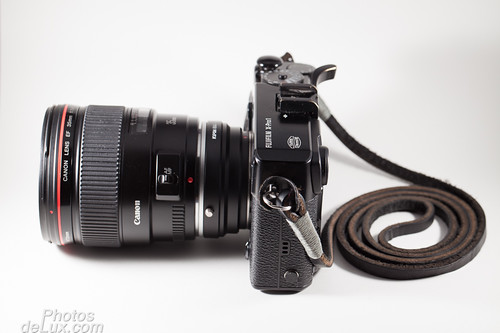
Side view of Fuji X-Pro 1 with Canon EF 35mm f1.4 L lens with adapter attached.
So much for the specs, let’s see how they compare in image quality.
I attached the X-Pro 1 to a sturdy tripod and set the X-Pro 1 to manual focus, ISO 200, shutter time 1/15s, fixed manual white balance (K) and 10 second timer to eliminate for camera shake. The photos were taken under controlled lighting.
I manually focused on the mittle of the “Rolleiflex” letters. The Canon lens does not auto focus when attached to the X-Pro 1 so I used manual focus for both lenses.
Here are the results:
Click on an image to be linked to a 100% full size view!
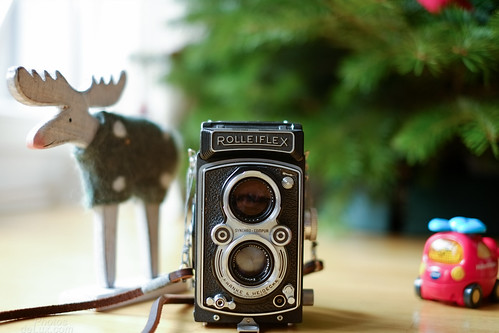
This is the result from the Fuji XF 35mm f1.4 R.
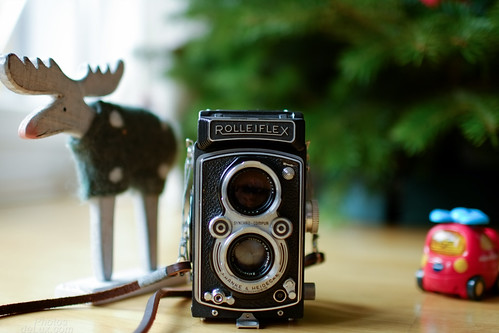
And this is the result from the Canon EF 35mm f1.4 L.
I redid this shot a few times for each lens as I noticed the difference in brigtness right away. But all variables stayed the same for both lenses - so the Canon lens seems to return about 2/3 of a f-stop darker results compared to the Fuji. So far I came up with two potential reasons for this difference:
1. The Canon lens has 11 glass elements versus the Fuji with only 8 elements. I have no idea how big of an impact this can make but it seems plausible that less glass elements between the light and the sensor will allow for more light to reach its destination. The f-stop value of a lens does not take this factor into account.
2. When the Fuji lens is attached to the camera the distance from X-mount surface to the sensor is only 1.8cm (0.7"). The light hits the sensor right after the last lens element. On the Canon EF with the Kipon EOS-XF lens adapter attached the distance is around 6cm (2.5").
I decided not to compensate the exposure on the camera to equal out the result in brightness. After all, I wanted a direct comparison between these two lenses with all factors that I can controll to be equal.
Now let's continue to image details:
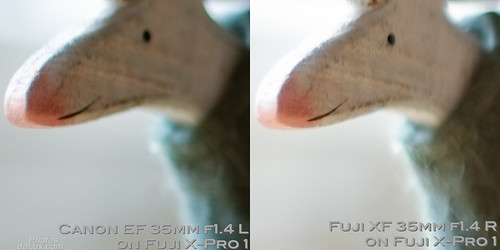
The left side of the photo shows the head of the wooden elk. This one is a bit hard to compare as the difference in luminance takes away some of the detail on the elk's nose and forehead on the Fuji lens image. But looking at the region between mouth and eye, the Fuji seems to be a bit sharper.
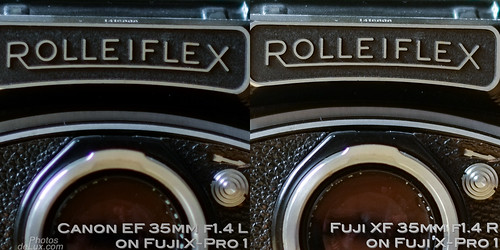 The "Rolleiflex" letters were the focus target close to the center. Here both lenses have their sweetspot but the Fuji clearly is sharper and shows less color fringing.
The "Rolleiflex" letters were the focus target close to the center. Here both lenses have their sweetspot but the Fuji clearly is sharper and shows less color fringing.
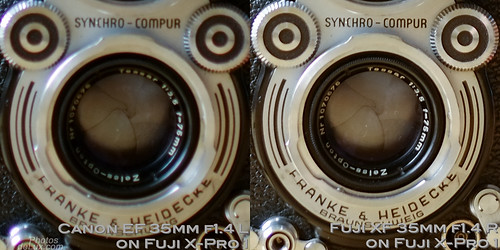
Moving a bit lower in the center of the frame the difference becomes even more apperant. The Fuji shows more detail and is sharper with a lot less color fringing. Even extra sharpening on the Canon lens image would not bring the photo up to the quality and detail of the Fuji lens.
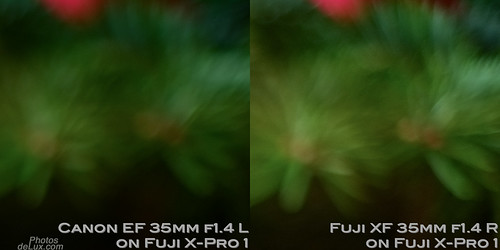
And the last sample is from the christmas tree on the top right of the image to compare the bokeh quality of both lenses. And while the Fuji's bokeh is good (here is my intensive test on the XF lenses bokeh), the Canon's bokeh is just that bit more smooth and creamy. This point goes to the Canon.
A few observations that I made during the test:
- While focusing I noticed that the Canon lens tended to show more color fringing from green to red while I was fine tuning the manual focus.
- The Canon was also more difficult to fine tune since the manual focus reacted rather fast and direct to small movements.
- The Fujinon on the other hand actually benefited from the fine graduation of the “focus by wire” setting in this situation at close focusing distances. This was the first time that I actually saw the benefit of this technology.
- The Fuji seemed to have a larger sweet spot of the sharp focus area depth compared to the Canon – even though both were set to f/1.4
I was surprised that the Fuji lens did this good in direct comparison to my favorite Canon lens!
But there is one factor in favor of the Fuji lens that also needs to be mentioned:
The X-Pro 1 recognizes the Fuji lens and applies some lens correction inside the JPG engine. The Canon lens does not get this special treatment and shows an uncorrected result from the lens. I could have partially avoided this by shooting in RAW but then the RAW converter of i.e. Adobe Camera RAW could have recognized the Fuji lens as well and add some auto correction. But in the end I wanted to see how the Canon lens compared when I use it on the X-Pro 1 in my normal use and this is what I got. The X-Pro 1 will not internally compensate for the Canon lens no matter what I do.
But if you happen to own some Leica M lenses and purchased the Fuji X-Mount to Leica M-adapter, then the Fuji will internally apply corrections to some of the Leica M lenses (i.e. the SUMMICRON-M 35mmF2 ASPH)
My resume:
The Canon EF 35mm f1.4 is a fantastic lens on my Canon FF DSLR camera. It has a fast Ultrasonic AF motor and the weight and size match the bigger camera body well. The Fujinon XF 35mm f1.4 R is a fantastic AF lens for the Fuji X-Pro 1 / X-E1 cameras. This comparison has solved the question for me if I could improve the image quality by using the Canon EF 35mm f1.4 instead of the XF 35mm f1.4 for special occasions. The answer for me is “No!” and I can now comfortably leave the bigger Canon 35mm lens attached to my Canon camera.“Bigger is not always better” :)
If you have any further questions leave a comment below or Twitter me @HamburgCam
And if you liked my post I am always happy if you spread the word and retweet, like or google +1 it :-)


Great comparison. Thanks for this. I just picked up a Fuji X-E1 this week to compliment my Canon 5D2 and bag of L's. The 35L is also my fav lens (the 135L is a close second!), so this comparison definitely is appreciated.
ReplyDeleteCheers from Manila.
You are welcome :)
DeleteAnd the 35L and 135L are also my favorite Canon FF lenses.
do you use other M-mount lens on your Xpro1 also?
ReplyDeleteNo, unfortunatels I don't have any Leica M lenses. But I do use old Olympus OM Zuiko lenses and really like them. Here is my review on the combination:
DeleteFuji X-Pro 1 with Olympus OM lenses
I'm also using some OM lenses with my x-e1 only one problem is that cheap adapter that I bought from amazon focus past infinity, have you got also this problem with your adapter?
DeleteBTW nice comparison!
A very nice comparison! Thanks a lot for sharing this one!
ReplyDeleteKind regards, Sebastian
Thank you for your nice reply :)
Delete> The 35mm focal length on an APS-C camera equals to a 52.5mm field of view (angle of view)...
ReplyDeleteI think you mean focal length, not field of view. For a 35mm rectilinear lens on an APS-C camera, the FOV will be about 44 degrees of arc.
Roger
Thank you for your reply Roger!
DeleteYou are correct that the way I phrased the sentance could be confusing angle of view with field of view :)
I now added the reference to the field of view of a "52.5mm lens" and rephrased the sentence to:
"The 35mm focal length on an APS-C camera equals the field of view (angle of view) of a 52.5mm lens on a regular 35mm full frame camera."
Does this now sound correct to what I wanted to say?
Perfect! 8=)
ReplyDeleteNice comparison, by the way. Makes me feel even happier about my purchase of the X-Pro1.
Roger
Great :)
DeleteI just got the Fuji 35 today and your review has been extremely helpful. I have some M glass - I'll try some comparisons on the XE1 with those too.
ReplyDeleteEC
Will you use the official M adapter from Fuji? It is supposed to even do some in camera correction for some of the supported lenses!
Deletefantastic review
ReplyDeletesteve costello
Thank you Steve :)
DeleteHeii, realy cool blog :) Very interesting, keep up the good work :) Thank You.
ReplyDeleteI will try not to dissapoint ;)
DeleteGreat...fantastic review. Thank Bro
ReplyDeleteYou are welcome :)
DeleteI trust more on a professional review site:
ReplyDeletehttp://slrgear.com/reviews/zproducts/canon35f14/tloader.htm
http://slrgear.com/reviews/zproducts/fuji35f14r/tloader.htm
You are free to trust any source that sounds most plausible to you. I have done many camera and lens comparisons throughout my career, and besides a natural variation even between 2 "same" 35mm L lenses there are countless possibility what actually gets tested and how does it get tested.
DeleteWhat you should always look at in any review is, what did they actually test. And often each review has there own setup so you can't compare review site "A" with results from review site "B".
Let me continue in your second comment below...
Look at the PHOTOS!! anything else is TOTALLY irrelevant.
DeleteAbsolutely agree. And I would strongly counter that "professional" review sites are not always editorially independent. Losing the advertising support of a major camera or lens manufacturer can jeopardise the entire business and ability to obtain sample glass for future reviews. I would trust a photographer every time, before I trust a journalist who happens to also be a photographer. Less chance of a conflict of interest - the photographer can be as honest as required.
DeleteAnother review from Photozone:
ReplyDeletePhotozone (the MT scale is different but the max value in the scale of for 35L (2100), corresponds to max value in the scale for XF 35mm (3100).
www.photozone.de/canon-eos/336-canon-ef-35mm-f14-test-rep...
www.photozone.de/fuji_x/746-fuji35f14?start=1
And even when comparing the review from the same review site, you can't just do an "A" to "B" comparison if not all the variables are identical.
DeleteI do like the photozone reviews, but find it often difficult to do an "A" to "B" comparison. Not all tests are done with the same camera (as camera and sensor technology evolves much faster than lenses do). Take the EF 35mm L for example. It has been tested with a 21 MPix FF 5D MK II and a 8 MPixel Crop 350D. The closest to compare to the Fuji X-Pro 1 would have been the 15 MPix Crop 50D, but photozone did not thest the 35mm f1.4 L with that camera, yet.
And even then you would not be comparing lenses, but different camera systems with those lenses against each others. And the sensor/camera body has a big influence on those results, too (micro lenses, AA filter etc).
So what I compared here was how the Fuji XF 35mm f1.4 compared to the Canon EF 35mm f1.4 L both attached to the X-Pro 1. Nothing more and nothing less. And neither of the reviews that you linked to did this.
And from what I have seen so far, I will choose the Fuji lens over the Canon 35mm L on the X-Pro 1 any day.
That said, the EF 35L is my most used and favorite lens on my 5D MK II :)
How about an update, would like to see your views between the 35 and the 18-55 @ 35
ReplyDeleteUnfortunately I don't have the XF 18-55mm lens and I'm currently not planing on buyinf it. Sorry.
DeleteHi Thanks for your really helpful insights, perhaps you can review the x-pro and look at the all the firmware updates to see what are the improvements overtime and highlight suggestions for Fuji for further "kaizen". I am sure someone from Fuji will take your feedback more seriously than us readers and will improve our future FW updates.
ReplyDeleteI suggest you do a simple comparison between v1.0 of X-pro vs the current v3.0 firmware and highlight the main upgrades. Please suggest future firmware improvements as Fuji will probably respect your inputs and improve all our cameras!
ReplyDeleteMany thanks!
Thank you for the suggestion. As there are still a few things that I would like to improve on the X-Pro 1 I might just do that :)
DeleteIn your review of the 35mm Fuji lens, you state:
ReplyDelete"...But if you happen to own some Leica M lenses and purchased the Fuji X-Mount to Leica M-adapter, then the Fuji will internally apply corrections to some of the Leica M lenses (i.e. the SUMMICRON-M 35mmF2 ASPH)..."
You seem to imply that somehow, the camera recognizes these manual lenses and makes automatic corrections. I know only of a way to do it manually by way of the Shooting menu #3 mount adapter corrections
sub-menu?
Am I missing something?
I am not sure if I understand exactly what your question is? But I'm reffering to this explanation by Fuji where you can set the corrections for your lenses and save them. The correction is then applied each time you use the respective lens:
Deletehttp://www.fujifilm.com/products/digital_cameras/accessories/lens/mount/fujifilm_m_mount_adapter/index.html
O.K. Then we are on the same page. The way you phrased it, it sounded like the Fuji will recognize the lens and in some way input the data automatically. I am aware of the manual input, and in that respect it makes no difference what M mount lens is used. Just push the button to bring up the menu and input from there. I guess I read more into your statement than was intended. Thank you for the clarification.
ReplyDeleteSorry if my wording caused some confusion about this. But it seems like not all Leica M lenses are compatible to the adapter as per the list that Fuji postes:
Deletehttp://www.fujifilm.com/products/digital_cameras/accessories/lens/mount/fujifilm_m_mount_adapter/compatibility_chart/
Maybe you can shead some light into why those other lenses aren't compatible? Is it a physical size problem concerning the mount?
Great article, very informative and good to read! Just one question, do you think that the depth of field differences could be due to the lens adapter pushing out the project point on the sensor, thereby creating a larger circle of confusion? You may be able to compensate for this by focusing a little closer on the Canon lens. This diagram on Wikipedia will hopefully explain what I'm trying to say http://en.wikipedia.org/wiki/File:Depth_of_field_illustration.svg.
ReplyDeleteGeorge
Interesting theory George!
DeleteI think that the DOF is generally the same on these two lenses attached to the same camera. But the contrast, sharpnes and bokeh look different. And I think that this is an issue of how the optical elements interact with the sensor at the same focus point.
If I were to focus to a different point with the Canon the focus zone would move and throw the "Rolleiflex" writing out of focus.
I think that the softer bokeh on the Canon has to do with different interaction of the glass elements inside the lens. A Canon 50mm f1.8 will have a different bokeh look than the f1.4 @1.8 as this is part of the lens characteristics.
But the circle of confusion plays a big roll when comparing different sensor sizes against each other. You can give it a try ba playing around with a DOF calculator like:
http://www.dofmaster.com/dofjs.html
Great comparison!
ReplyDeleteBut be aware, because of Fuji lens on fuji body is already corrected Fuji's lens defect.
Is it possible for you to make the other two image, Fuji's lens on Canon's body compared with Canon's L lens on Canon body (may be APS-C). I don't think Fuji's lens at this price is free from chromatic aberration.
I use my full frame lenes on APS sensors professoinally. What is not addressed here is the image size mis-match at the focal plane. The image size of the FF lens is far bigger than the sensor (hence the cropped image). This can cause the FF lens to bath the throat of the camera with off sensor light. The result is often a very noticeable loss of contrast and metering errors at best. A bright sky or bright light source in the outer field of a FF lens but off the APS sensor can be disastrous.You're lighting up internals in the camera that may not have been designed to be bathed in light.
ReplyDeleteA simpler way of putting this is - The FF lens is designed to project an image of 36X24mm. An APS sensor is only 62% of that size. Where does the wasted perimeter light go?
The best solution is to use more restrictive hoods on FF lenses when mounted on APS or smaller sensors. A hood that just allows enough of the FF image circle that vinyetting does not occur on the APS is optimal. Just remember to take it off before you mount it back on the FF camera. My students are taught this with a cadaver 40D with a ground-glass element mounted in the sensor window. Yes its on my tests.
Try putting such a hood on your canon 35 and see what you find.